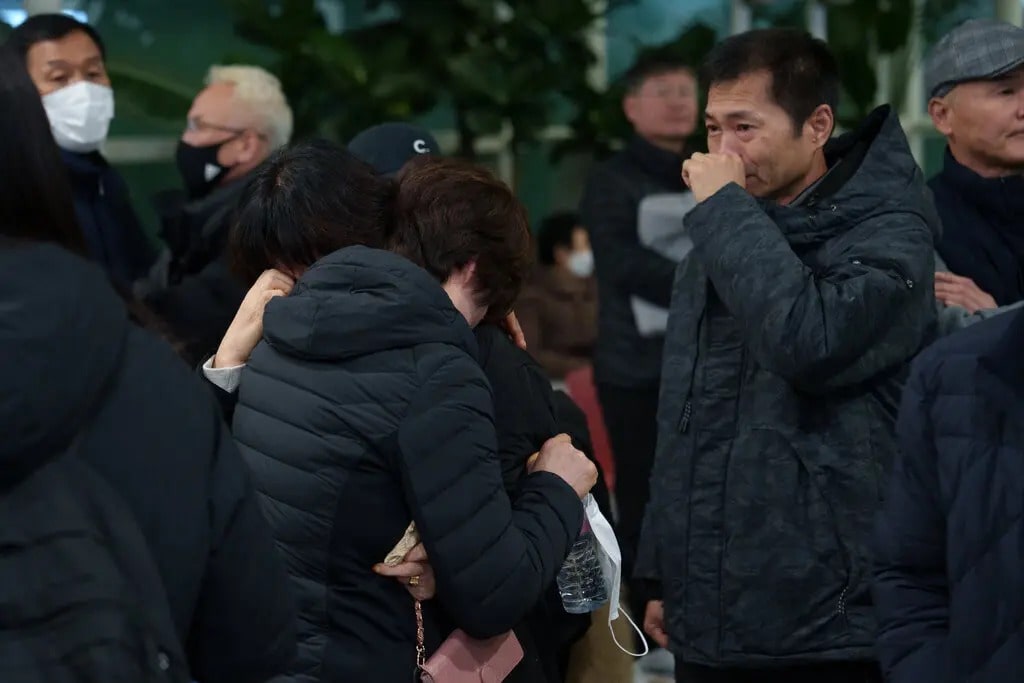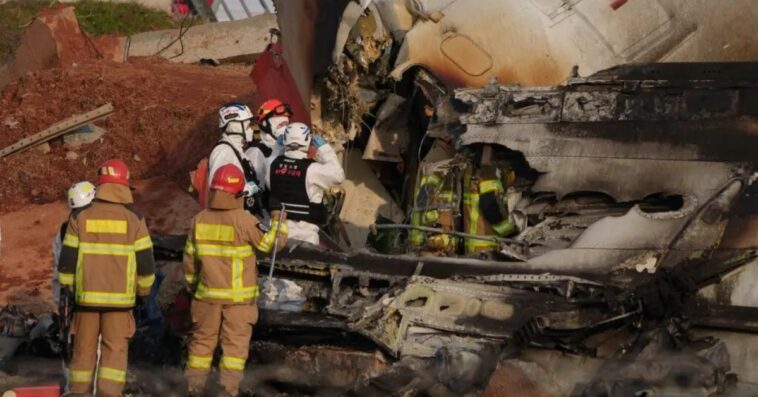South Korea recently experienced its deadliest plane crash in almost 30 years. A passenger plane carrying 181 people crash-landed and exploded in flames at Muan International Airport.
The disaster claimed 179 lives, leaving only two survivors. Now, people are asking: What caused this terrible accident?
The Incident: A Flight to Catastrophe

People gathered at Muan International Airport, anxiously awaiting news about the victims of the crash. | Photo Credits: Chang W. Lee/The New York Times
The crash happened on Sunday when a Boeing 737-800, operated by Jeju Air, was flying from Bangkok, Thailand, to Muan International Airport in South Korea.
The plane, called Flight 7C2216, tried to land around 9 a.m. local time. Instead of landing safely, it crashed onto its belly, slid into a barrier, and burst into flames.
The plane was almost completely destroyed. Only the tail section of the aircraft remained recognizable. Out of 175 passengers and six crew members, just two crew members survived. They were found in the tail section and rescued.
Investigating the Causes
Investigators are trying to figure out why the crash happened. Several possible reasons are being considered, including problems with the landing gear, bad weather, and even a bird strike.
Landing Gear Failure
Early reports suggest the landing gear, which helps the plane land safely, may not have worked. The plane’s wing flaps, which slow the plane down, also might not have opened. Aviation expert Keith Tonkin said the plane seemed to be set up for flying, not landing. This could mean the plane was moving too fast as it approached the runway.
Bird Strike Warning
Before the crash, the airport issued a warning about a possible bird strike. Migratory birds often rest in tidal flats near the airport. Some local news showed videos of flames briefly coming from one of the engines. This suggests that a bird might have hit the engine.
Weather Considerations
Bad weather has also been mentioned as a possible cause. However, it hasn’t been confirmed that the weather played a major role in the crash.
Ju Jong-wan, an official from South Korea’s Ministry of Land, Infrastructure, and Transport, said that plane crashes usually happen because of several reasons combined. Figuring out the exact cause could take a long time.
Jeju Air and Its Safety Record
This was the first fatal crash for Jeju Air, a low-cost airline started in 2005. The airline flies to many places across Asia.
Maintenance and Recent History
Just two days before the crash, this same plane was diverted to Seoul. However, the diversion was due to a medical emergency, not a technical problem. Between that time and the crash, the plane completed 10 flights without any issues.
Past Investigations
In 2021, Jeju Air was investigated after one of its planes flew with a damaged wing tip. The crew didn’t notice the damage. Despite this, South Korea’s Ministry of Land, Infrastructure, and Transport gave Jeju Air an “A” safety grade in 2023. This means the airline’s safety record was considered “very good.”
Boeing 737-800: A Trusted Aircraft
The Boeing 737-800 is a very popular and trusted plane used all over the world.
Global Usage
There are about 4,400 Boeing 737-800 planes flying worldwide. They make up 15% of all passenger planes.
Design and Reliability
Najmedin Meshkati, an engineering professor at the University of Southern California, said the Boeing 737-800 has a strong safety record. Its landing gear is usually very reliable. However, he explained that maintenance problems or a bird strike could explain why the landing gear might have failed in this crash.
South Korea’s Deadliest Crash Since 1997
This crash is the worst aviation disaster South Korea has faced since 1997. Back then, a Korean Air jet crashed into a hill in Guam, killing 229 of the 254 people onboard.
What’s Next?

It could take years to fully investigate this crash. Officials need to gather all the evidence to understand what happened. They are looking at the landing gear, possible bird strikes, and the plane’s maintenance history.
This tragedy reminds us how complicated air travel can be and how important it is to follow strict safety rules. South Korea mourns the lives lost in this crash, but the incident also highlights the need for better technology and safety measures to prevent similar disasters in the future.
What do you think the aviation industry can do to improve safety and avoid accidents like this? Share your thoughts with others and help spread awareness about the importance of air travel safety.


